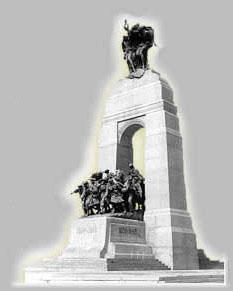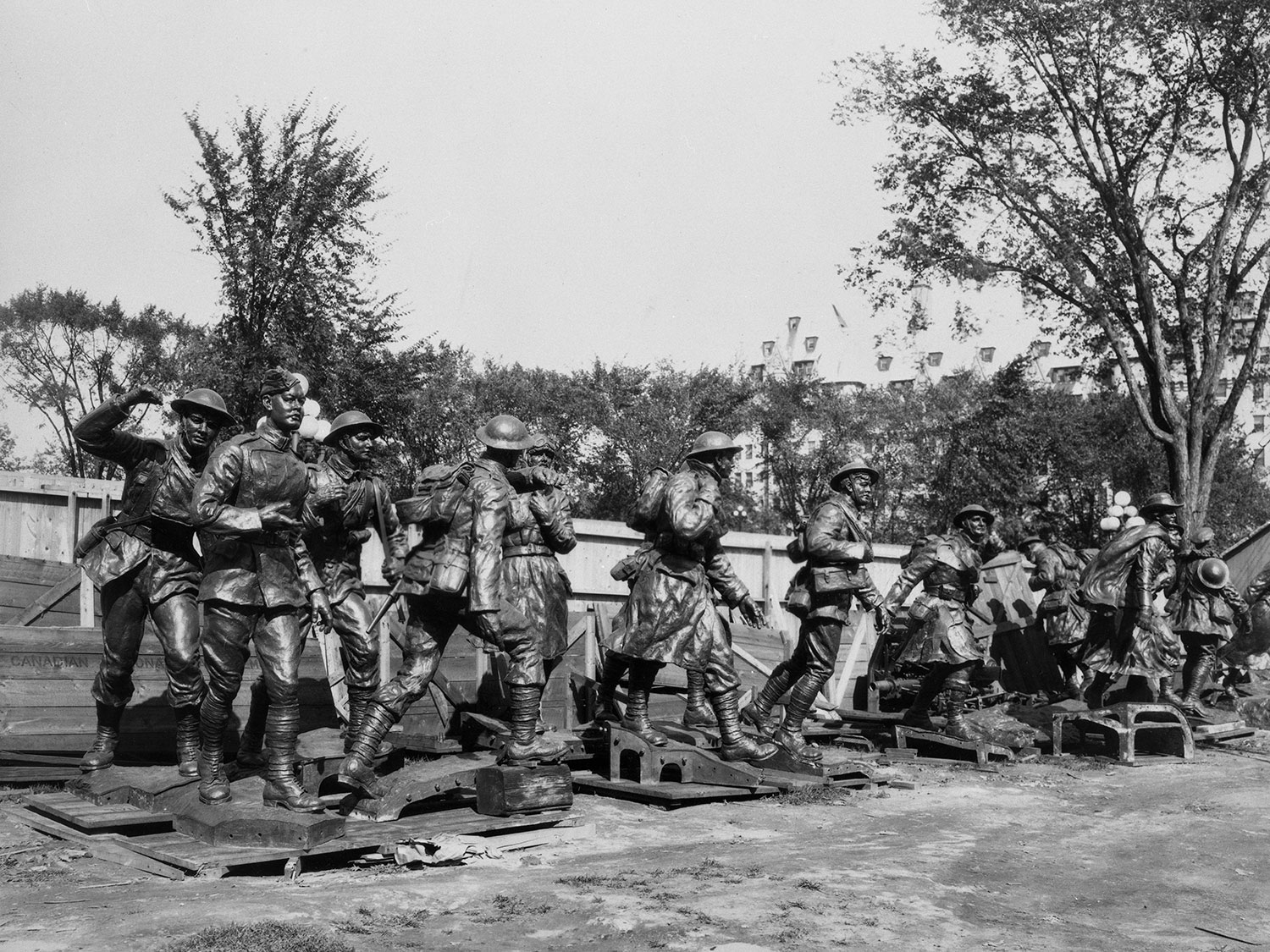
Canada's National War Memorial
Ottawa

Canada's National War Memorial
Ottawa
The War Memorial was designed by sculptor Vernon March of Farnborough, Kent, England, and was unveiled by His Majesty King George VI in 1939. The monument comprises of an arch of granite surmounted by emblematic bronze figures of Peace and Freedom. Shown advancing through the archway are 22 bronze figures symbolic of the "Great Response" of the hundreds of thousands of Canadians who answered the call to serve.
All branches of the service engaged in the war are represented. Leading the way are infantrymen, the mainstay of the Army.
In the front is an infantryman carrying the basic load which weighed 60 lbs. At the far left is another infantryman,
portrayed older than the rest with a Lewis gun over his right shoulder, on his left and slightly behind is another
infantryman with his rifle over his shoulder. The respirator he is wearing was a significant item in a soldiers kit
for poison chlorine gas that the Germans introduced in 1915 at Ypres. In front of the cavalryman's horse stand another
infantryman depicted with a curly moustache. The other soldier beside the cavalryman might well represent one of the 3,500
native Canadians who served in the war overseas.
At the front to the right is a kilted soldier with the barrel a Vickers machine gun over his left shoulder.
There were 28 Scottish Regiments in the war. Next to the kilted soldier is an infantryman depicted very youthful in appearance,
appropriate of the many soldiers of the First World War that were still in their teens. The soldier with his rifle
placed horizontally on his left shoulder could represent the Motor Machine Gun Corps, a force of some 16,000 were
responsible for devastating firepower on the battlefield. The artilleryman mounted on the horse on the right was
to assist the infantryman by means of heavy bombardment of enemy lines. A sailor is located on the far right wears
a "cap tally' of HMCS Stadacona. The RCN grew to more than 5,500 officers and men by 1918.
The pilot and air mechanic stand side-by-side in front of the mounted artilleryman. A cavalry soldier is mounted
on a horse on the left of the monument. A sapper at the rear of the arch carries a pick axe over his right shoulder.
They were responsible for building roads, bridges and tunnels and for water supplies and major fortifications.
The soldier at the rear of the arch, carries a railway spike hammer over his right shoulder. The railways carried men,
ammunition and supplies to the front. With his broad-brimmed hat and his cant hook over his shoulder the forester
is easy to locate at the rear of the monument. The Canadian Forestry Corps. produced railroad ties, logs for road
building and timber for major fortifications.
Inside the arch is a soldier who could represent those in the
Canadian Army Service Corps, which supplied the troops with food, ammunition and other supplies.
With his goggles on the front of his field service cap, the dispatch rider stands out at the left rear of the monument.
To the rear of the sailor stands a member of the Canadian Corps of Signals. From his shoulder hangs a field telephone
that was used to communicate in the trenches and between unit headquarters. The stretcher bearer is to the right rear
of the monument. Just behind him are two nurses representing the Canadian Army Medical Corp
There is field artillery piece, an 18-pounder in the very rear of the monument.

The Canadian Tomb of the Unknown Soldier is located in front of the National War Memorial.
The tomb was added to the war memorial in 2000, and holds the remains of an unidentified Canadian
soldier who died in France during World War One.
The tomb is built of Caledonia granite and it has a bronze relief sculpture and four bronze corner pieces.
The bronze work was designed by Canadian artist Mary-Ann Liu and cast in Roberts Creek, British Columbia.
Both the tomb and sculpture reflect some of the themes and style of the Vimy Memorial.The three-tiered sarcophagus
is 12 feet long, 8 feet wide and 3 feet high. Dark Caledonia granite, quarried in Rivière à Pierre, Québec,
was selected to complement the paler-coloured stone used in the National War Memorial. While it is patterned
after the stone altar of the Vimy Memorial, the severe Ottawa climate, as well as the bronze and stone makeup
of the National War Memorial, led to the decision to produce the relief work in bronze.
The bronze sculpture, will include the key elements of the stone carving on the Vimy altar; a medieval sword,
a helmet of the type worn in the First World War, with branches of maple and laurel leaves. The laurel leaves
symbolize both victory and death. Four bronze corner pieces containing symbolic mementos of mourning will
enhance the sculpture. Three of the corner pieces will be decorated with large replicas of the Memorial Cross.
First instituted in 1919, the Cross is presented to the family of those who gave their lives while serving
Canada in war or on peacekeeping missions. The three Crosses are slightly different; each has the Royal Cypher
of one of the successive monarchs since its inception (George V, George VI, and Elizabeth II). On the
fourth corner piece there will be a replica of a poppy, representing those who may fall in future conflicts.
The curved shape of the corner pieces will echo the curve of the top of the War Memorial.
